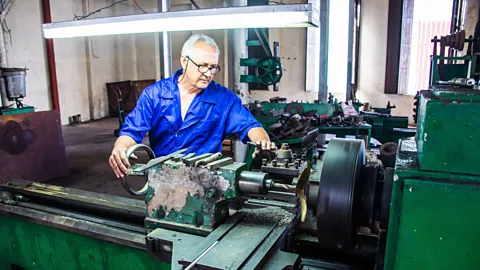The untapped potential of the ‘longevity economy’
 Alamy
AlamyWith increased lifespans, elders are living thousands of days longer. That’s very good news for the global economy.
Youth may be poised to inherit the future, but now ageing populations are defining it.
In 2018, for the first time in history, those aged 65 or older outnumbered children younger than five globally. And the number of people aged 80 years or older is projected to triple, from 143 million in 2019 to 426 million in 2050.
The population aged 65 and older is growing faster than all other age groups, especially as the global birth rate has been plummeting since the second half of the 20th Century. According to the World Health Organization, fertility rates in every region except Africa are near or below what’s considered the ‘replacement rate’ – the level needed to keep a population stable. In most high-income countries this hovers around 2.1 children per woman.
The population isn’t just ageing, though: people are living longer and increasing their ‘healthspan’ for prolonged health, too. That means that as the population of elders increases, so grows a group of consumers, workers and innovators. In other words, they’re not simply a group that needs services from the ‘silver economy’, which is aimed solely at older and ageing people – rather, the ageing population can continue to be full-service participants in the economy at large.
“We’re now talking about a new life stage which is as long as the latter part of your adult life,” says Dr Joseph Coughlin, director of the Massachusetts Institute of Technology AgeLab and author of Longevity Economy: Unlocking the World’s Fastest-Growing, Most Misunderstood Market.
 Alamy
AlamyLife stages can be quantified in fairly equal measurements of days, he says: 0 to 21, 21 to 40 and 40 to retirement age all measure about 8,000 days. “If you make it to 65 years old, you have more than 50% chance you’ll make it over age 85 – that’s [another] 8,000 days. So we’re now looking at a third of our adult life where there are no stories, tools, rewards or expectations.”
As elders live longer and healthier lives, and continue to actively participate in the global economy, possibilities open to potentially turn longevity into an asset for society.
In 2015, Americans aged 50 and older generated nearly $8 trillion worth of economic activity. The Boston Consulting Group projects that by 2030, the 55-plus population in the US will have accounted for half of all domestic consumer spending growth since the global financial crisis. The number rises to 67% in Japan and 86% in Germany.
With elders driving a substantial portion of the world’s economic activity now and in the future, the ‘longevity economy’ could open up currently untapped opportunities for growth.
Challenging ‘oldness’
Global societal ageing has generally been considered detrimental to a country’s economic health, since it reduces the workforce and increases burdens on healthcare systems.
At this year’s G20 meeting in Japan, where ageing was on the priority list for discussion for the first time, Bank of Japan Governor Haruhiko Kuroda said that an ageing population could pose “serious challenges” for central banks.
A recent United Nations report also warned that global ageing would increase the “fiscal pressures that many countries will face in the coming decades as they seek to build and maintain public systems of health care, pensions and social protection for older persons”. This could be particularly impactful for the many countries around the world with growing numbers of retirees.
 Alamy
AlamyBut MIT’s Coughlin thinks that even though populations may be ageing in significant numbers, we can’t let the idea of ‘oldness’ and its implications stifle the way we think about economic opportunity. He argues that oldness is a social construct that doesn’t reflect how people realistically live after middle age, and says that businesses need to serve what older people actually want, not what conventional wisdom suggests they need. That’s not just cars for old men, say, but rather fun, fashion and far more.
“It’s about being ‘ageless’ – things that are more personalised, more focused on well-being, on things being very easy. Those value sets are generationally agnostic,” says Coughlin. He adds that although millennial demands are linked to the rise of the on-demand economy, older adults benefit immensely from its convenience. “For the really old, it’s turned into a virtual assistance living.”
Although there isn’t a lot of research available about the longevity economy itself, what’s clear is that if businesses are able to tap this ageing consumer base in this new phase of their lives, that could mean major opportunity. After all, these groups are spending. KPMG’s 2017 report of online consumers in 51 countries revealed that baby boomers spend the most online at $203 on average per transaction, compared to ‘tech-savvy’ millennials, who actually spend the least at $173 on average.
The biggest market for the longevity economy may be Japan, the world’s fastest ageing nation. From small conveniences, such as providing reading glasses labelled “feel free to use these” at post offices, banks and hotels, to larger structural improvements such as providing buttons at pedestrian crossings that can be pushed to provide extra time to cross, modern Japanese culture accommodates everyday needs to its ageing population.
With at least 20% of Japan’s current population older than 70, its inclusive culture is also reflected in how elders consume right alongside the younger generations – at local swimming pools, on package holidays and in exercise classes to name a few. The emergence of a new generation of elders online – such as Bon and Pon, who share snaps of their travels and activities by wearing matching outfits – is an example of how elderly generations are consuming and enjoying life like younger people.
Prolonging employees’ working lives
A key part of longevity and increased healthspan is the freedom to work. When workers are living healthier, longer lives, an ageing workforce can be an opportunity to reap what consultancy Deloitte calls the ‘longevity dividend’ – being able to boost economic productivity from older employees.
In Germany, keeping ageing workers on the job is a matter of national economic stability. More than 21% of the German population is older than 65. Credit rating agency Moody’s says that Germany’s ageing population poses risks to its economic strength; if Germany ever loses its triple-A credit rating, Moody’s has warned that the likely reason will be “the impact of demographic change on the German economy and social security systems”.
In light of health and life expectancy advances, a German aged 65 today is expected to live about another 20 years, according to the OECD. Yet due to the physically demanding nature of the manufacturing industry, retaining workers on factory floors until retirement age will continue to be a challenge.
 Alamy
AlamySome German companies are using advances in technology to accommodate ageing workers and keep them active. At Porsche’s plant in Leipzig, ergonomics are deployed to help workers who typically operate in hour-long shifts, rotating from station to station throughout the day. The entire factory is mapped out with a traffic-light system indicating ergonomic comfort, so managers can schedule shifts that ensure body parts are not burdened.
“The aim of ergonomics is not to react but to be preventive,” says Alissa Frey, ergonomics specialist at Porsche Leipzig. “The rotation between different manufacturing steps helps to prevent one-sided strains. Furthermore, process and component adjustments, force limits, height-adjustable workspaces, handling-devices and supporting systems as well as an appropriate deployment of our employees avert a physical overload.”
But whether increased longevity is a burden or a dividend depends on how much societies prepare for the challenges of ageing populations as well as identify and maximise its benefits.
“The baby boomers have created a next generation,” says Coughlin. “So there is the expectation that while they’re no longer young, they do feel perennially youthful. They not just expect, but in many cases demand new products, new services, new experiences, to make every stage of life – if not every day – a little bit better.”
